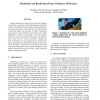Free Online Productivity Tools
i2Speak
i2Symbol
i2OCR
iTex2Img
iWeb2Print
iWeb2Shot
i2Type
iPdf2Split
iPdf2Merge
i2Bopomofo
i2Arabic
i2Style
i2Image
i2PDF
iLatex2Rtf
Sci2ools
95
Voted
SIBGRAPI
2008
IEEE
2008
IEEE
Simulation and Rendering of Opus Palladium 3D Mosaics
Mosaic sculptures are a form of art where the sculpture is made from a collection of individual elements called tiles which are distributed over the surface of a given 3D shape. To add expressiveness, artists distribute the tiles following a high-level design over the shape, in order to emphasize some features. In the method known by mosaicists as Opus Palladium, or simply “crazy paving”, tiles with irregular shapes are used, improving the expressivity of the final result. In this work, we present a method to simulate this kind of 3D mosaic by representing tiles as Voronoi polygons computed from a distribution of points on the surface of the 3D object. Previous work on this topic have used only square-shaped tiles. Special mosaic-like effects are obtained with the help from texture maps, which control the high-level design of the tiles.
Computer Graphics | Elements Called Tiles | Mosaic Sculptures | SIBGRAPI 2008 | Square-shaped Tiles |
| Added | 01 Jun 2010 |
| Updated | 01 Jun 2010 |
| Type | Conference |
| Year | 2008 |
| Where | SIBGRAPI |
| Authors | Vladimir Alves dos Passos, Marcelo Walter |
Comments (0)

